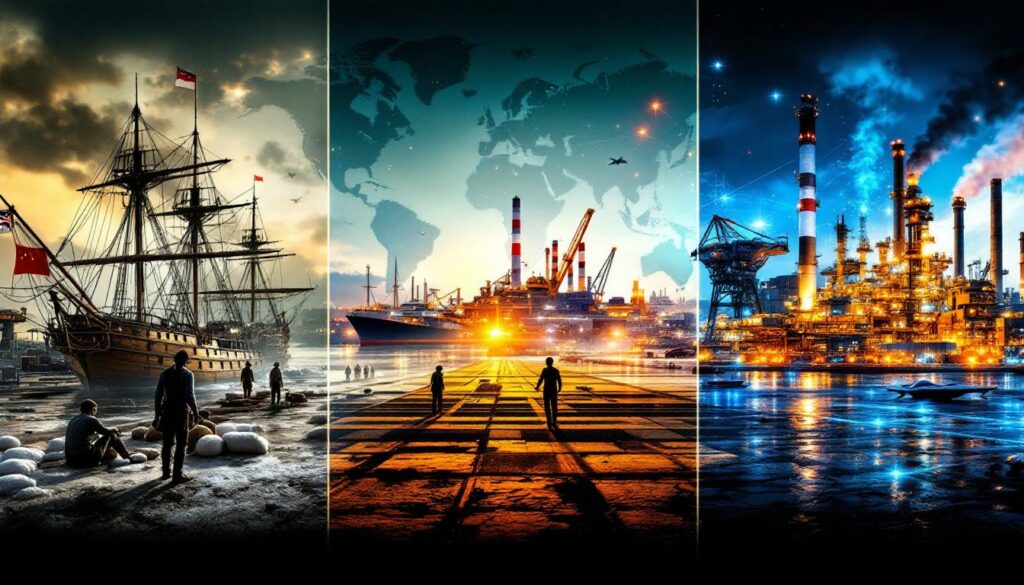The Hidden Power of Trade: How Resource Control Shapes Global Politics
Throughout history, one principle has remained constant in international relations: trade and historical influence reveals the truth about power. While politicians make grand statements and media headlines sensationalize conflicts, examining who controls essential resources and supply chains provides deeper insights into actual power relationships between nations.
Trade as the Ultimate Truth-Teller
"Trade tells the truth. It exposes who really holds the cards versus who just holds the microphone," explains geopolitical analyst J Martin. This fundamental principle has remained consistent from ancient civilizations to modern geopolitical tensions.
In both historical and contemporary contexts, the nation that controls critical resources often wields more influence than those with apparent military advantages. Resource dependencies have historically determined military capabilities, territorial expansion, and imperial influence. Today's global supply chains create similar vulnerabilities but with greater complexity and interconnectedness.
Modern nations face challenges comparable to historical empires when critical minerals security is controlled by potential adversaries. This creates power imbalances that transcend military strength alone and often contradicts the narratives presented in political speeches or media coverage.
How Did Resource Control Shape Colonial Power?
The story of saltpeter (potassium nitrate) during the colonial era provides a compelling case study of how resource control translated directly into military dominance and imperial power.
The Strategic Importance of Saltpeter
In the 18th century, saltpeter was the essential ingredient for gunpowder production. Without this critical oxidizing component, cannons couldn't fire and muskets were useless—rendering military forces effectively powerless regardless of their size or training.
The regions of Bengal and Bihar in India contained the world's richest saltpeter deposits, making control of these areas strategically vital. Whoever managed these resources gained tremendous military advantage over their rivals, demonstrating how geographic resource distribution can shape power dynamics independently of other factors.
From Local Production to Industrial Exploitation
By the 15th century, Indian regions were already producing saltpeter through decentralized, small-scale operations managed by local merchants. Production methods were relatively simple but effective, with extraction and refining techniques passed down through generations of specialists.
This indigenous industry underwent dramatic transformation when the British East India Company began importing raw saltpeter from India in the 1600s. Initially, the company used saltpeter merely as ballast in their ships returning to Britain—a practical solution for maintaining ship stability while maximizing profitable cargo space.
The Industrialization of Resource Extraction
As European warfare evolved toward larger armies and extended campaigns requiring substantial gunpowder supplies, the British East India Company recognized saltpeter's strategic value. Around 1650, they shifted focus to systematic saltpeter production, constructing large-scale refineries in Bengal and transforming local production methods.
The results were staggering: saltpeter exports surged from approximately 50 tons annually to over 2,000 tons under British management—a 4,000% increase. This massive production scale-up parallels modern resource exploitation patterns we see today in mining industry evolution and energy resources.
This industrialization of resource extraction exemplifies how colonial powers leveraged control of raw materials to maintain military superiority while simultaneously generating immense profits—a pattern that continues to influence global trade patterns in modified forms today.
How Do Modern Resource Dependencies Compare to Historical Patterns?
The fundamental principles connecting resource control to power remain unchanged, though the specific resources and political arrangements have evolved. Indonesia's nickel industry provides a revealing modern parallel to historical resource dependencies.
Indonesia's Nickel Industry: A Modern Case Study
Indonesia possesses the world's largest nickel reserves—a critical component in high-performance and stainless steel production. Nickel's unique properties make it essential for applications ranging from military hardware to medical equipment, particularly due to its exceptional resistance to heat and cold.
Despite this natural wealth, Indonesia initially exported only raw, unrefined nickel and remained economically subordinate within global markets. This pattern of exporting unprocessed resources at low margins while importing finished goods at premium prices has trapped many resource-rich nations in cycles of underdevelopment.
The Transformative Impact of Foreign Investment
Following strategic Chinese investment in Indonesia's nickel sector, a remarkable transformation occurred. Indonesia's global market share of refined nickel jumped from 19% to an astonishing 61%—resulting in a 1,700% increase in nickel revenue for the country.
This near-monopolistic control exceeds even OPEC's peak market share of 51% in 1973, granting Indonesia unprecedented leverage in global nickel pricing and supply chains. As J Martin notes, "Despite Indonesia having resource wealth, they were only exporting raw unrefined nickel and were not a major player. Chinese investment changed that."
What makes this case particularly significant is that China built approximately 74% of Indonesia's nickel processing infrastructure, creating a strategic partnership that benefits both nations while fundamentally altering global supply chains for this critical metal.
Comparing Colonial and Modern Investment Models
While Chinese investment in Indonesia differs significantly from British colonization in India (being based on economic partnership rather than territorial control), both cases demonstrate how resource-rich developing nations often require external capital and technological expertise to fully leverage their natural advantages.
The key difference lies in agency and benefit distribution: colonial extraction typically exploited local resources primarily for the colonizer's benefit, while modern partnerships like the China-Indonesia nickel relationship involve mutually beneficial arrangements where both parties gain significant advantages, though not necessarily in equal measure.
This evolution represents a more sophisticated form of resource politics—one where control operates through financial and technological leverage rather than direct territorial occupation, yet still shapes trade and historical influence in profound ways.
How Has Trade Been Weaponized Throughout History?
The strategic denial of critical resources has proven to be a powerful weapon in international conflicts, often more effective than direct military confrontation. The Napoleonic Wars provide one of history's clearest examples of how trade weaponization can decisively alter the balance of power.
Napoleon vs. Britain: The Saltpeter Embargo
Between 1797 and 1805, Napoleon transformed France from a revolutionary state into Europe's dominant military power. After decisive victories at Jena and Austerlitz, Britain recognized Napoleon not merely as a national leader but as the architect of a new European empire with potential designs on Britain itself.
This perception of existential threat prompted a strategic response centered not on direct military confrontation—where French forces excelled—but on economic warfare targeting a critical vulnerability: gunpowder production.
Strategic Resource Denial as Warfare
Rather than engaging Napoleon primarily on battlefields where French forces held advantages, Britain weaponized its control of saltpeter supplies. In 1805, the British redirected saltpeter exports from India exclusively for British use, cutting off France's access to this critical military resource.
This strategy exemplifies how tariffs and investment impact can serve as a force multiplier in conflicts, allowing nations to leverage economic advantages to compensate for military disadvantages. As J Martin observes, "Britain didn't beat Napoleon in a single battle. It bled his empire over years by weaponizing trade."
The Consequences of Resource Dependency
Facing this critical shortage, French scientists attempted to develop domestic saltpeter production using animal waste, manure pits, and nitrification beds. However, these alternatives produced inconsistent and inferior results compared to the high-quality saltpeter from India's Bengal region.
The consequences manifested gradually but inexorably: French weapons began misfiring while British cannons remained reliable, creating a material disadvantage that compounded over time. Napoleon's forces increasingly faced not just enemy armies but also the degradation of their own military capability due to inferior supplies.
The Slow Collapse of Napoleon's Military Advantage
By Napoleon's disastrous 1812 Russian campaign, his Grand Army faced not only logistical challenges and harsh weather but also critical material shortages affecting weapons reliability. Britain's resource strategy had systematically undermined French military capabilities through indirect means, demonstrating how trade control can prove more effective than direct military confrontation.
This historical example shows that apparent military superiority can be neutralized through supply chain vulnerabilities—a lesson that remains critically relevant in today's complex global economy development where resource dependencies create similar strategic leverage points.
What Does America's Current Resource Dependency Reveal?
Despite America's advanced weapons systems and massive defense budget, its military industrial complex faces critical vulnerabilities due to resource dependencies that mirror historical patterns in surprising ways.
Critical Vulnerabilities in Defense Supply Chains
The United States relies heavily on imported materials for its defense manufacturing, creating potential strategic weaknesses. Two dependencies stand out as particularly significant: Indonesian nickel for high-performance steel and Chinese-processed rare earth elements for various advanced technologies.
What makes these dependencies notable is their connection to geopolitical competitors. The Indonesian nickel industry received substantial Chinese investment, with China building approximately 74% of Indonesia's nickel processing infrastructure. Meanwhile, China controls roughly 90% of global rare earth element processing—materials essential for everything from missile guidance systems to aircraft components.
The Challenge of Domestic Alternatives
While the U.S. is attempting to develop domestic rare earth mining operations, processing these materials domestically presents far greater challenges than merely extracting them. Establishing competitive processing capabilities would require decades of planning, extensive environmental accommodations, and tens of billions in capital investment.
Even with significant government support, these operations would likely remain inefficient for years, making it difficult to compete with established processing centers. This mirrors France's unsuccessful attempts to develop domestic saltpeter production during the Napoleonic era—showing how difficult it is to rapidly replace established supply chains for critical materials.
Trade Dependencies as Deterrents to Conflict
China's substantial control over materials essential to American weapons manufacturing creates a significant deterrent to direct military conflict. This resource leverage makes sensationalist narratives about imminent U.S.-China military confrontation improbable, illustrating how trade relationships often contradict political rhetoric and media speculation.
As J Martin concludes, "I view a hot war between the United States and China as highly unlikely" precisely because of these deep resource interdependencies. This assessment aligns with the "trade tells the truth" principle—beneath heated political rhetoric, the reality of material dependencies reveals more balanced power relationships.
What Historical Lessons Apply to Modern Trade Conflicts?
Historical patterns of trade weaponization provide valuable insights into when and how nations might leverage resource control in contemporary conflicts.
The Profit Motive vs. National Security
Despite centuries of intermittent warfare between Britain and France, the British East India Company continued selling saltpeter to France until 1805. Through conflicts including the Seven Years' War and support for American revolutionaries, trade continued uninterrupted. As a profit-driven entity, the company prioritized commercial interests over national security concerns until Napoleon posed an existential threat to Britain itself.
This pattern reveals an important principle: economic self-interest generally prevails in trade relationships until security concerns become overwhelming. The threshold for weaponizing trade is surprisingly high, requiring perception of direct existential threat rather than routine competition or limited conflicts.
The Threshold for Trade Weaponization
Historical evidence suggests nations typically weaponize trade only when facing direct existential threats, not during routine geopolitical competition. This pattern informs predictions about modern trade conflicts, suggesting that despite rhetoric about decoupling economies or restricting technology transfer, complete trade weaponization remains unlikely absent a fundamental security crisis.
The reluctance to fully weaponize trade stems from its double-edged nature—restricting exports to adversaries also harms domestic industries and disrupts global supply chains on which all major economies depend. This creates powerful incentives to maintain trade relationships even during periods of significant political tension.
The Strategic Value of Supply Chain Control
Both historical and contemporary examples demonstrate that controlling critical resource supply chains often provides more leverage than military superiority alone. Nations dependent on adversaries for essential materials face fundamental vulnerabilities regardless of their apparent strength in other domains.
This principle applies equally to great powers and smaller nations. Even the most powerful military force becomes compromised when denied access to critical materials—as demonstrated by Napoleon's experience with saltpeter shortages and potentially by modern militaries facing rare earth element restrictions.
In today's interconnected world, these dependencies create a web of mutual vulnerabilities that simultaneously constrain conflict and reshape how power operates in the international system. Understanding these dynamics provides a more nuanced view of global affairs than simplistic narratives about military competition or ideological confrontation.
Building Resilient Supply Chains: The New Strategic Imperative
The historical lesson for contemporary policymakers is clear: supply chain resilience represents a core national security concern. Nations that ignore resource dependencies risk finding themselves in positions similar to Napoleonic France—possessing apparent strength that can be undermined through indirect means.
Building truly resilient supply chains requires more than identifying vulnerabilities—it demands realistic assessment of what can be produced domestically versus what requires international cooperation. Complete self-sufficiency proves impractical for even the largest economies, making strategic partnerships with resource-rich nations an essential component of modern security planning.
FAQ: Understanding Trade's Impact on Global Power
How does resource dependency affect military capabilities?
Resource dependency creates vulnerabilities that can neutralize apparent military advantages. As demonstrated by Napoleon's experience with saltpeter shortages, even the most formidable military force becomes compromised when denied access to critical materials. Modern militaries face similar vulnerabilities with rare earth elements and specialized metals required for advanced weapons systems.
The impact typically manifests gradually rather than immediately. Military equipment doesn't suddenly stop functioning, but performance degrades over time as replacement parts become scarce or lower quality alternatives must be substituted. This degradation compounds over extended conflicts, potentially becoming decisive in wars of attrition.
Can domestic production replace foreign resource dependencies?
Replacing established foreign supply chains with domestic alternatives typically proves challenging, time-consuming, and initially inefficient. France's attempts to produce saltpeter domestically during the Napoleonic era yielded inferior results, similar to how modern nations struggle to develop domestic rare earth processing capabilities that can match established operations in countries like China.
While domestic production can reduce vulnerabilities, complete self-sufficiency rarely proves economical or technologically feasible. More realistic approaches involve diversifying supply sources, maintaining strategic reserves, and developing partnerships with multiple supplier nations to prevent excessive dependence on any single source.
What determines when trade becomes weaponized in international relations?
Historical patterns suggest that nations typically weaponize trade only when facing existential threats. The British East India Company continued selling saltpeter to France despite ongoing conflicts until Napoleon's continental dominance posed a direct threat to Britain's security. This suggests economic interests generally prevail until security concerns become overwhelming.
The threshold appears to be perception of existential danger rather than routine competition. Minor conflicts, ideological differences, or economic rivalry rarely prompt complete trade weaponization. Only when national survival appears directly threatened do states typically accept the significant economic costs associated with severing valuable trade relationships.
How do modern supply chain vulnerabilities compare to historical examples?
Modern supply chain vulnerabilities involve greater complexity and interdependence than historical examples but follow similar principles. Just as Britain leveraged its control of saltpeter from India against Napoleon, China's dominance in rare earth processing creates leverage against the United States despite America's military advantages.
The key difference lies in the interconnected nature of today's global economy, where supply chains span multiple countries and involve numerous processing stages. This creates more potential points of vulnerability but also makes complete disruption more difficult, as alternative sources—though often more expensive or less efficient—can sometimes be developed.
Conclusion: Trade as the Foundation of Global Power
The relationship between trade and power reveals a fundamental truth often obscured by political rhetoric: control over critical resources shapes international relations more profoundly than military capabilities alone. From the saltpeter trade of colonial India to modern lithium industry initiatives and gold safe haven dynamics, resource dependencies create leverage that transcends traditional measurements of national power.
Understanding these dynamics provides a more nuanced view of global affairs than conventional analyses focused primarily on military capabilities or political statements. By examining who controls essential resources and supply chains, we gain deeper insights into actual power relationships between nations—insights that often contradict prevailing narratives about international competition.
As we navigate an increasingly complex global landscape, the ancient principle that "trade tells the truth" offers a valuable framework for cutting through rhetoric to understand the fundamental realities shaping our world. In this reality, nations remain bound by material dependencies that both constrain conflict and create opportunities for cooperation, even amid significant political tensions.
Want to Spot the Next Major Resource Discovery Before the Market Does?
Discover why significant mineral discoveries can lead to exceptional market returns by exploring Discovery Alert's dedicated discoveries page, where their proprietary Discovery IQ model transforms complex geological data into actionable investment insights for ASX-listed companies.




